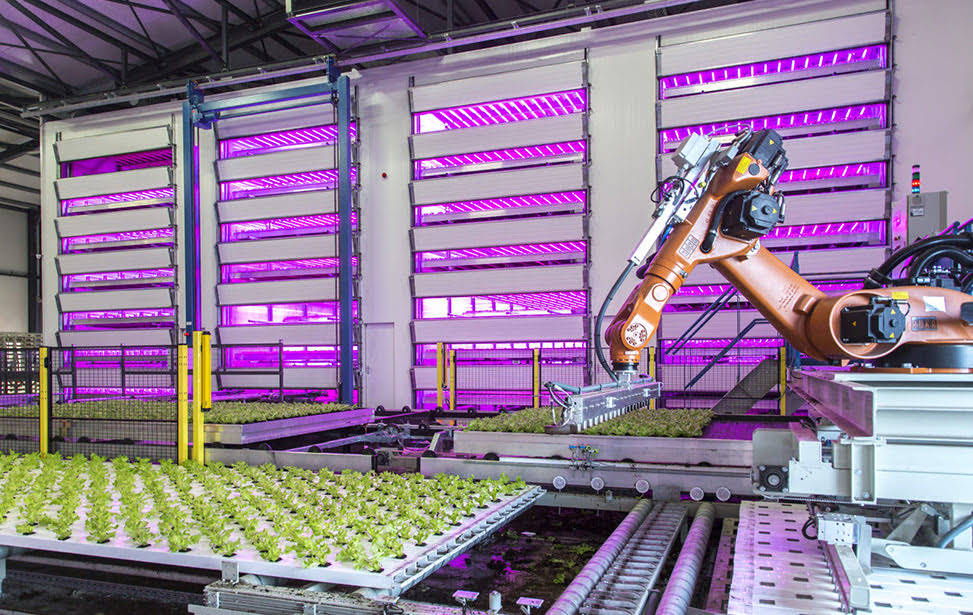- English

How is vertical farming going to change food production? No one can predict the future, but vertical farming has been identified as an important development in the growing demand for healthy food. Product Engineer Pim de Jong is going to provide us with detailed information about the advantages and challenges associated with this form of indoor food production and will share Codema’s vertical farming vision.
Vertical farming definition: the explanation
Vertical farming is the cultivation of food in stacked layers, in a fully controlled environment. Light, energy and water are controlled in a way which creates cultivation conditions which are as efficient and sustainable as possible, without any need for external influences. This allows for any possible location to be used for indoor cultivation, such as a factory hall or an office building.
Pim de Jong is involved with the development of vertical farming systems at Codema, where he ended up as a result of his fascination for complex systems.
“I worked in solar energy and energy storage for this purpose. When I first arrived at Codema, I was surprised at how advanced horticulture already was and it seemed like a great challenge to be able to come up with more and even better systems. Our Research & Development team is working on various different issues. I generally tend to favour energy, as I find this an incredibly interesting field. And vertical farming has given me the perfect challenge to rise to.”
The advantages of vertical farming
The grower has full control of the cultivation area and cultivation process in a vertical farm. This allows the grower to guarantee a reliable supply of fresh produce throughout the entire year. There are obviously no external influences in an enclosed environment and the space, energy and raw materials are all used as efficiently as possible. This doesn’t just result in a saving of water and nutrients, but also a higher food production with a lower impact on the environment. Vertical farming allows for local production, which means less transport and a further limitation of emissions. Vertical farms have been identified as an important way of satisfying the growing demand for safe food in the future as a result of this combination of factors.
“Vertical farming offers solutions for locations where it’s too hot, too cold or too busy for food production. And for locations where the soil isn’t suitable for agriculture. Some examples include Los Angeles, Oslo or Mumbai. Large cities with plenty of inhabitants, where growing food is a tricky business. Vertical farming ensures we can make the chain from production to consumption a great deal smaller and allows us to provide the population with fresh, healthy food throughout the entire year.”
The most important challenge in vertical farming
The flow of products is currently the biggest challenge in vertical farms. The vertical farm has to be organised in such a way that the crops are ripe at just the right time and can instantly be delivered.
“We can influence the crops’ growth cycle with heat and CO2. A nursery therefore usually works with different departments and temperatures for the different production phases. Vertical farming also allows us to plan for the crops to be ripe at the right time like this. Important developments are the lamps, which we can use to adjust the light spectrum and control the software.”
One advantage of vertical farming is that you can produce throughout the entire year, without being dependent on the seasons, the weather and daylight. This ensures the production process can continue for 24 hours a day, an important element where guaranteeing the flow is concerned.
“The advantage of a completely automatic system is the ability to continue working, we can plan this with our software and ensure the flow of ripe produce.”
Codema offers scalability with the modular vertical farming system
“Vertical farming is wrongly seen as a pioneering market, as there are already a number of different companies active in this sector. Codema’s knowledge of, and experience with, water management, lighting, air circulation, climate control, cultivation systems, logistics, software and engineering means it has everything required for a vertical farm.”
Its various different expertises has allowed Codema to develop a fully automatic, modular system for making vertical farming scalable. Codema can therefore offer the grower all the tools for complete control of the food production.
Codema’s innovations in water management, logistics, climate control, lighting, software and engineering offer global food producers new answers to business questions. If you have a problem or challenge for which our insight could provide a contribution to a solution, please do get in touch!
For more information: www.codemasystemsgroup.com